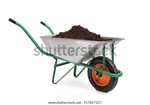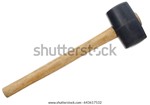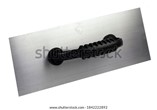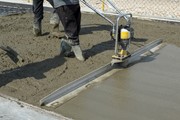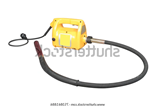Welcome to carry out concreting to simple forms. This module specifies the skills and knowledge required to safely install formwork, reinforcement and place and finish concrete for the construction of minor slabs, pathways and other minor works to a specified design finish, meeting all relevant requirements of the National Construction Code (NCC), Australian Standards, work health and safety (WHS), and Commonwealth and state or territory legislation.
As you progress through the learning, you will learn how to:
- plan and prepare for the concreting task
- erect simple formwork
- place and tie reinforcement
- place concrete
- strip simple formwork
- clean up the site.

Legislation and the Australian Standards in the construction industry ensures the quality of constructing buildings and ensures the safety of people. The following legislation is relevant to carrying out concreting:
- Building Act 2004 (and relevant state and territory instruments)
- Building Regulations (relevant to each state/territory)
- Work Health and Safety Act 2011 (and relevant state and territory instruments)
- Work Health and Safety Regulations 2011 (and relevant state and territory instruments)
- The Environmental Planning and Assessment Act 1979 (and relevant state and territory instruments)
- The Environmental Planning and Assessment Regulations 1979 (and relevant state and territory instruments)
- Other state and territory-based legislation and policies affecting buildings as described in NCC2019 (See Schedule 1)
- Relevant local laws depending on local government area.
The following Australian Standards are relevant to this unit:
- AS 3600: 2018 Concrete structures
- AS 3610.1: 2010 Formwork for concrete
- AS 3610.1: 2018 Formwork for concrete, Part 1: Specifications
- AS 4671: 2001 Steel reinforcing materials
- AS 2870: 2011 Residential slabs and footings
- AS 3972: General purpose and blended cements
- AS 2870: the Australian Standard for residential slabs and footings7
You also need to be mindful that legislation the Australian Standards can be subject to change. You will need to ensure you keep up to date and monitor any changes that may have occurred.
When carrying out concreting, there are tools that are required for use. The following table illustrates the common tools and equipment associated with concreting:
|
Picture |
Tool/equipment |
Use |
Serviceability |
|
|
Shovel/spade |
To load materials into wheelbarrow |
Handle/grip is secure and in good condition, shaft is in good working order and free from cracks/splits/splinters, blade and collar is secure, blade is not bent or warped. |
|
|
Hammer |
To drive/remove nails |
Signs of damage such as loose/cracked handle, chips or cracks in head, hammer is clean and dry before and after use. |
|
|
Bolt cutters |
To cut reinforcement materials |
Blades are clean and sharp, pins/fasteners are secure. |
|
|
Wheelbarrows |
To transport small loads or pre-packaged materials |
Check that the wheel isn’t flat or punctured, the wheel isn’t loose, the handles are secure, the barrow itself isn’t rusting through, the wheel moves easily. |
|
|
Mallet |
To set pegs |
Signs of damage such as loose/cracked handle, chips or cracks in head, mallet is clean and dry before and after use. |
|
|
Broom |
For broom finishing and clean up |
Broom is clean and free of debris, handle and broom head are securely fastened, no splinters on handles |
|
|
Float trowel |
For smoothing concrete |
Check handle and float are securely connected, clean trowel and make sure it is dry. |
|
|
Screed boards |
For smoothing and levelling concrete |
Boards are clean and free of cement, make sure they are dry. |
|
|
Mixer machine/ cement mixer |
Used to evenly mix water, cement and aggregates to make concrete |
|
|
|
Mixer truck |
Concrete or mixer trucks are mix large quantities of cement, aggregates, and water. The large drum is able to continuously turn if transporting large quantities to a specified location. The cement trucks also have a trough which enable to the mixed concrete to be dispersed. |
|
|
|
Immersion vibrator |
Used for vibrating concrete. They remove the air-bubbles from concrete. 10 |
|
|
|
Surface vibrators |
Used in conjunction with immersion vibrators. Vibrating and compacting concrete slabs, roads, and industrial floors10 |
|
|
|
Used for high density reinforcement. Best used on concrete floors, beams, and one-sided blind walls.10 |
|
The formwork is the integral aspect of concreting. What you will come to find throughout your career and the ore experience you have with formwork, is if the formwork is not accurately erected and stripped, the integrity of the concrete will be severely implicated.
There are several types of formworks that can be used in the construction industry. Let us take a look at some of these formwork types and their advantages.8
Traditional timber formwork
This type of formwork is among the first types of formworks ever used. Made from timber or plywood, this type of formwork can be built on site and is relatively easy to create (and considered cost effective), however the longevity of the timer formwork is quite short and is considered time consuming for lager projects. While this type of formwork is older, it is still used where complex sections need a flexible type of formwork. 8
Engineered formwork systems
This type of formwork is made from steel or aluminium and built from prefabricated modules. This type of formwork is quick to construct with the use of pins and clips and is considered to be very durable; it can be used over and over with minimal need to replace it. 8
Reusable plastic formwork
This type of formwork is created with durable yet light weight plastic which creates an interlocking modular system. Plastic formwork is perfect for repetitive construction projects and is considered lower maintenance. Because it is made from plastic, there is no need for a removing agent, such as form oil and can be cleaned with water. 8
Permanent insulated formwork
Permanent insulated formwork is considered an advancement in formwork systems. It is energy efficient, sustainable, and environmentally friendly. The type of formwork has been manufactured to be permanently insulated to provide an extra layer of thermal, acoustic, fire resistant and rodent resistant properties. What makes this type of formwork unique is the use of polystyrene foam that stays in place after the concrete has been cured. 8
Stay in place formwork
This type of formwork is not removed once the concrete has set. It is able to be assembled onsite made from prefabricated fibre reinforced plastic shaped in hollow tubes for columns and peers. Because it stays in place, once the concrete sets, it acts as axial and shear reinforcement which prevents environmental damage such as corrosion and freeze-thaw cycles. 8
Flexible formwork
This type of formwork incorporates the use of lightweight but durable sheets of fabric carefully designed to complement the workability of concrete and create unique building forms. Flexible formwork is different to the other types of formworks we have just looked at because it uses less concrete therefore making for a cost effective and energy saving product. 8





